Business Valuation and Analysis
VerifiedAdded on 2023/03/21
|15
|2676
|60
AI Summary
Valuation of a company is a very complex task that requires substantial knowledge in the field of accounting. There are number of valuation techniques that are available to determine the value of a company. In case of acquisition of target companies as well as selling of a company the management uses the services of the experts to determine the value of these companies. It helps management to either acquire a target company at correct value or to get correct price for selling a company’s share. As mentioned that there are number of different valuation techniques which are used by management to ascertain the value of a company however, the discounted cash flow method and price earnings ratio method are two of the most popular methods used to ascertain value of a company. Valuation of ABC Company using these two methods show that there is significant difference in the values calculated between discounted cash flow method and price earning method.
Contribute Materials
Your contribution can guide someone’s learning journey. Share your
documents today.
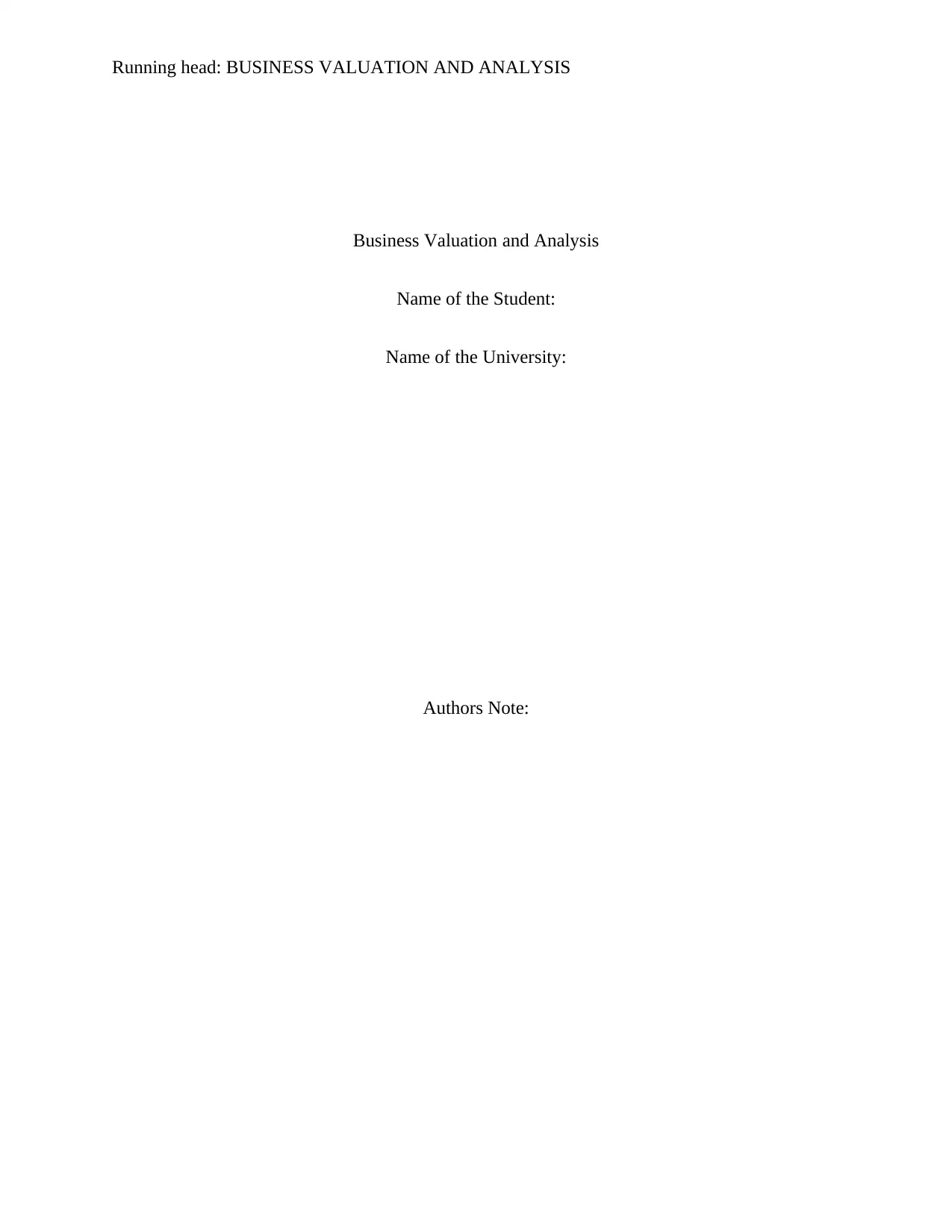
Running head: BUSINESS VALUATION AND ANALYSIS
Business Valuation and Analysis
Name of the Student:
Name of the University:
Authors Note:
Business Valuation and Analysis
Name of the Student:
Name of the University:
Authors Note:
Secure Best Marks with AI Grader
Need help grading? Try our AI Grader for instant feedback on your assignments.
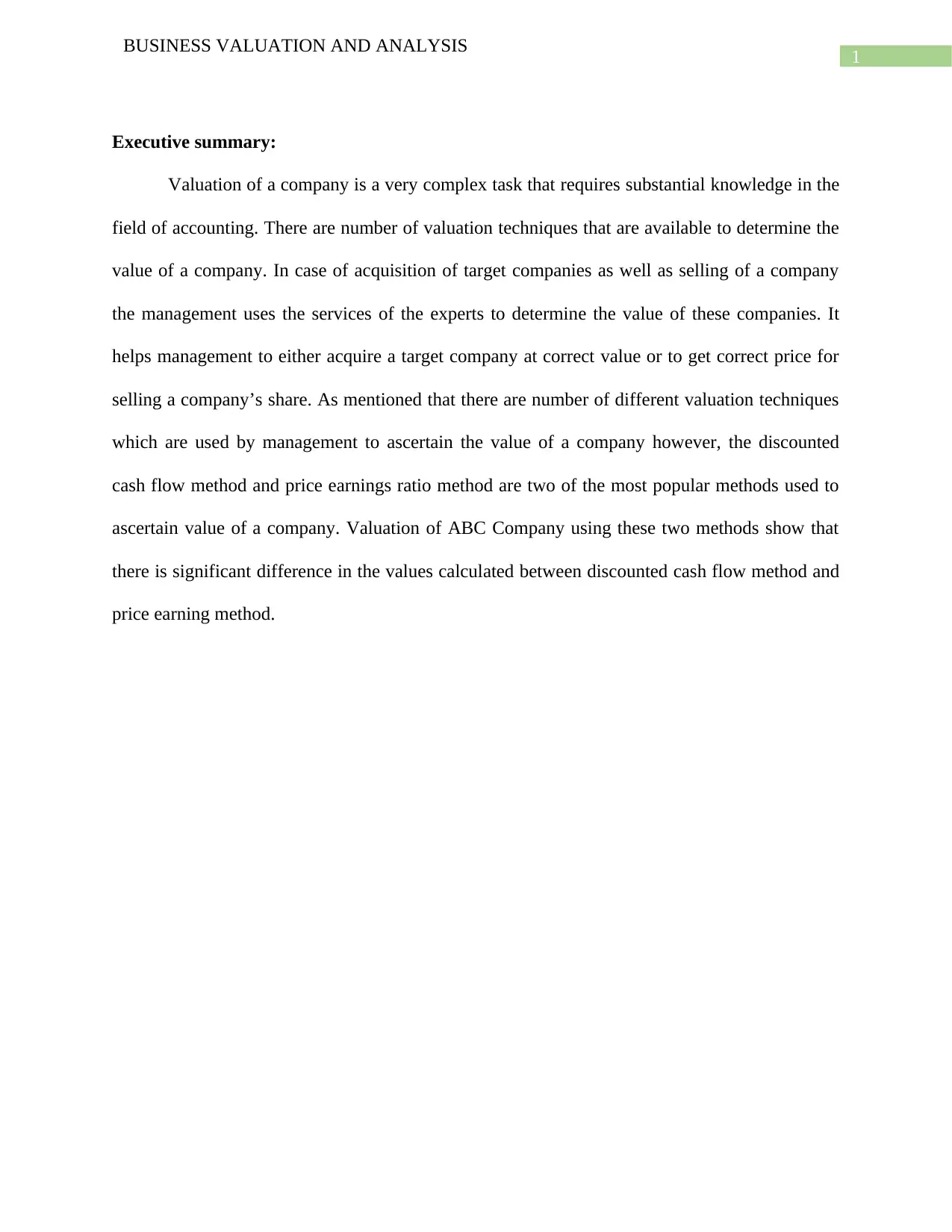
1
BUSINESS VALUATION AND ANALYSIS
Executive summary:
Valuation of a company is a very complex task that requires substantial knowledge in the
field of accounting. There are number of valuation techniques that are available to determine the
value of a company. In case of acquisition of target companies as well as selling of a company
the management uses the services of the experts to determine the value of these companies. It
helps management to either acquire a target company at correct value or to get correct price for
selling a company’s share. As mentioned that there are number of different valuation techniques
which are used by management to ascertain the value of a company however, the discounted
cash flow method and price earnings ratio method are two of the most popular methods used to
ascertain value of a company. Valuation of ABC Company using these two methods show that
there is significant difference in the values calculated between discounted cash flow method and
price earning method.
BUSINESS VALUATION AND ANALYSIS
Executive summary:
Valuation of a company is a very complex task that requires substantial knowledge in the
field of accounting. There are number of valuation techniques that are available to determine the
value of a company. In case of acquisition of target companies as well as selling of a company
the management uses the services of the experts to determine the value of these companies. It
helps management to either acquire a target company at correct value or to get correct price for
selling a company’s share. As mentioned that there are number of different valuation techniques
which are used by management to ascertain the value of a company however, the discounted
cash flow method and price earnings ratio method are two of the most popular methods used to
ascertain value of a company. Valuation of ABC Company using these two methods show that
there is significant difference in the values calculated between discounted cash flow method and
price earning method.
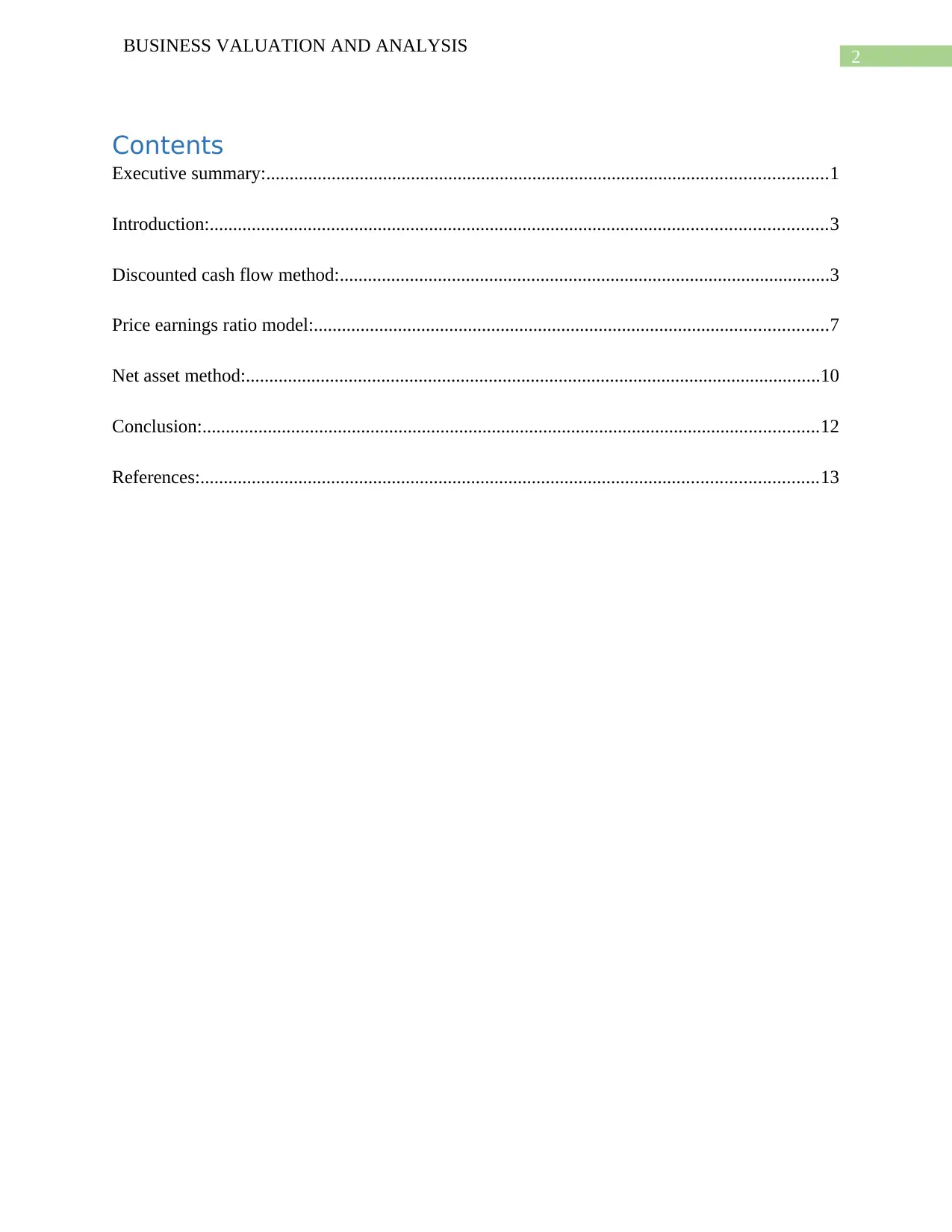
2
BUSINESS VALUATION AND ANALYSIS
Contents
Executive summary:........................................................................................................................1
Introduction:....................................................................................................................................3
Discounted cash flow method:.........................................................................................................3
Price earnings ratio model:..............................................................................................................7
Net asset method:...........................................................................................................................10
Conclusion:....................................................................................................................................12
References:....................................................................................................................................13
BUSINESS VALUATION AND ANALYSIS
Contents
Executive summary:........................................................................................................................1
Introduction:....................................................................................................................................3
Discounted cash flow method:.........................................................................................................3
Price earnings ratio model:..............................................................................................................7
Net asset method:...........................................................................................................................10
Conclusion:....................................................................................................................................12
References:....................................................................................................................................13
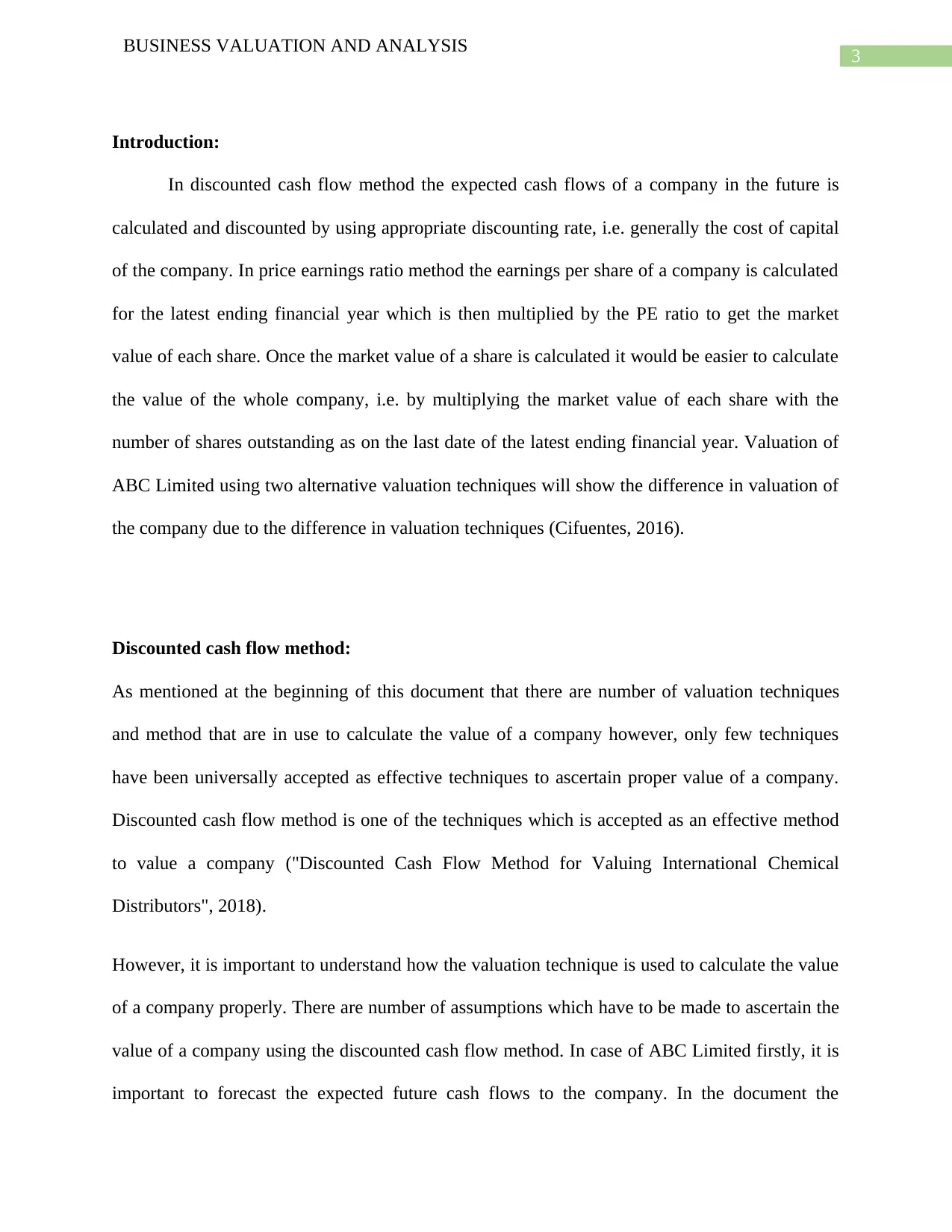
3
BUSINESS VALUATION AND ANALYSIS
Introduction:
In discounted cash flow method the expected cash flows of a company in the future is
calculated and discounted by using appropriate discounting rate, i.e. generally the cost of capital
of the company. In price earnings ratio method the earnings per share of a company is calculated
for the latest ending financial year which is then multiplied by the PE ratio to get the market
value of each share. Once the market value of a share is calculated it would be easier to calculate
the value of the whole company, i.e. by multiplying the market value of each share with the
number of shares outstanding as on the last date of the latest ending financial year. Valuation of
ABC Limited using two alternative valuation techniques will show the difference in valuation of
the company due to the difference in valuation techniques (Cifuentes, 2016).
Discounted cash flow method:
As mentioned at the beginning of this document that there are number of valuation techniques
and method that are in use to calculate the value of a company however, only few techniques
have been universally accepted as effective techniques to ascertain proper value of a company.
Discounted cash flow method is one of the techniques which is accepted as an effective method
to value a company ("Discounted Cash Flow Method for Valuing International Chemical
Distributors", 2018).
However, it is important to understand how the valuation technique is used to calculate the value
of a company properly. There are number of assumptions which have to be made to ascertain the
value of a company using the discounted cash flow method. In case of ABC Limited firstly, it is
important to forecast the expected future cash flows to the company. In the document the
BUSINESS VALUATION AND ANALYSIS
Introduction:
In discounted cash flow method the expected cash flows of a company in the future is
calculated and discounted by using appropriate discounting rate, i.e. generally the cost of capital
of the company. In price earnings ratio method the earnings per share of a company is calculated
for the latest ending financial year which is then multiplied by the PE ratio to get the market
value of each share. Once the market value of a share is calculated it would be easier to calculate
the value of the whole company, i.e. by multiplying the market value of each share with the
number of shares outstanding as on the last date of the latest ending financial year. Valuation of
ABC Limited using two alternative valuation techniques will show the difference in valuation of
the company due to the difference in valuation techniques (Cifuentes, 2016).
Discounted cash flow method:
As mentioned at the beginning of this document that there are number of valuation techniques
and method that are in use to calculate the value of a company however, only few techniques
have been universally accepted as effective techniques to ascertain proper value of a company.
Discounted cash flow method is one of the techniques which is accepted as an effective method
to value a company ("Discounted Cash Flow Method for Valuing International Chemical
Distributors", 2018).
However, it is important to understand how the valuation technique is used to calculate the value
of a company properly. There are number of assumptions which have to be made to ascertain the
value of a company using the discounted cash flow method. In case of ABC Limited firstly, it is
important to forecast the expected future cash flows to the company. In the document the
Secure Best Marks with AI Grader
Need help grading? Try our AI Grader for instant feedback on your assignments.
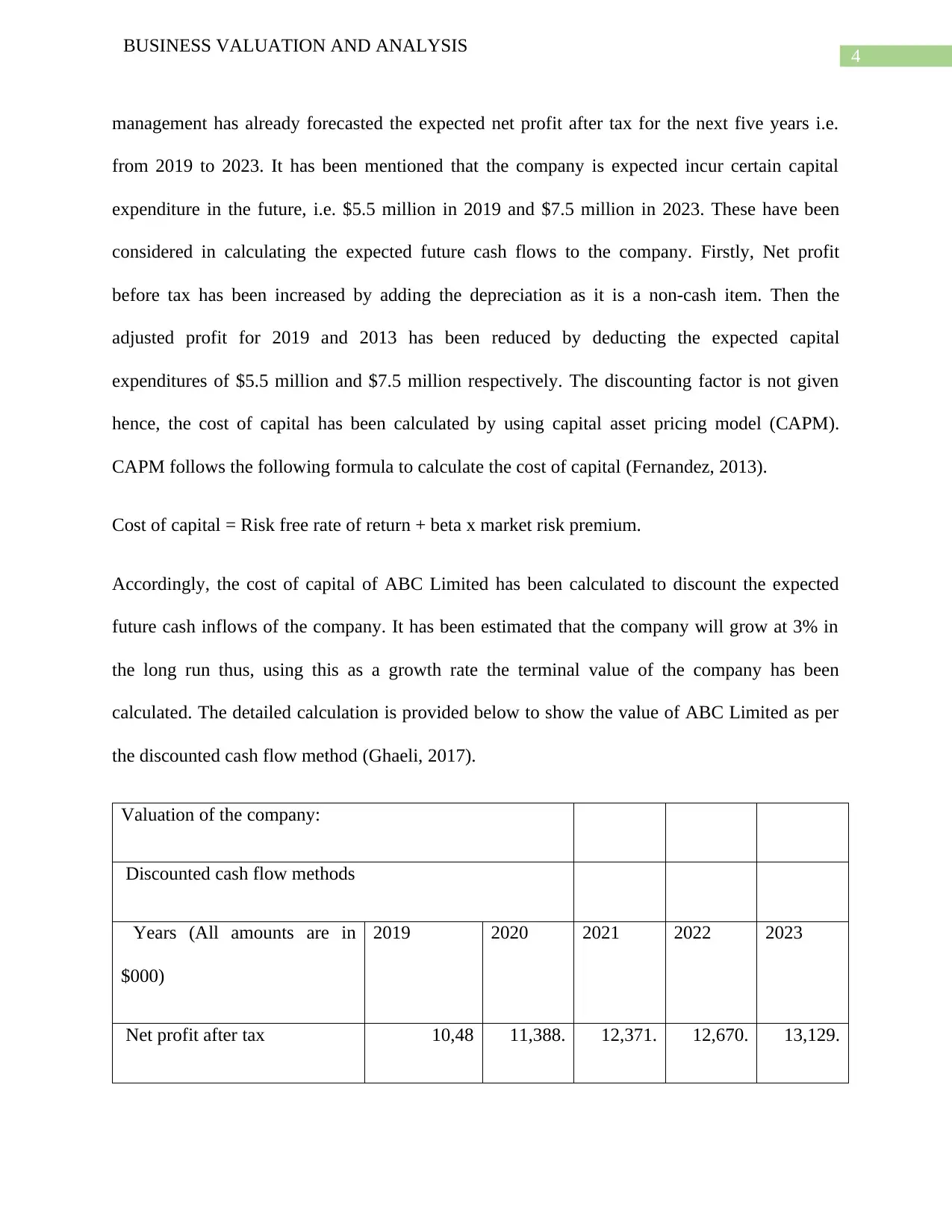
4
BUSINESS VALUATION AND ANALYSIS
management has already forecasted the expected net profit after tax for the next five years i.e.
from 2019 to 2023. It has been mentioned that the company is expected incur certain capital
expenditure in the future, i.e. $5.5 million in 2019 and $7.5 million in 2023. These have been
considered in calculating the expected future cash flows to the company. Firstly, Net profit
before tax has been increased by adding the depreciation as it is a non-cash item. Then the
adjusted profit for 2019 and 2013 has been reduced by deducting the expected capital
expenditures of $5.5 million and $7.5 million respectively. The discounting factor is not given
hence, the cost of capital has been calculated by using capital asset pricing model (CAPM).
CAPM follows the following formula to calculate the cost of capital (Fernandez, 2013).
Cost of capital = Risk free rate of return + beta x market risk premium.
Accordingly, the cost of capital of ABC Limited has been calculated to discount the expected
future cash inflows of the company. It has been estimated that the company will grow at 3% in
the long run thus, using this as a growth rate the terminal value of the company has been
calculated. The detailed calculation is provided below to show the value of ABC Limited as per
the discounted cash flow method (Ghaeli, 2017).
Valuation of the company:
Discounted cash flow methods
Years (All amounts are in
$000)
2019 2020 2021 2022 2023
Net profit after tax 10,48 11,388. 12,371. 12,670. 13,129.
BUSINESS VALUATION AND ANALYSIS
management has already forecasted the expected net profit after tax for the next five years i.e.
from 2019 to 2023. It has been mentioned that the company is expected incur certain capital
expenditure in the future, i.e. $5.5 million in 2019 and $7.5 million in 2023. These have been
considered in calculating the expected future cash flows to the company. Firstly, Net profit
before tax has been increased by adding the depreciation as it is a non-cash item. Then the
adjusted profit for 2019 and 2013 has been reduced by deducting the expected capital
expenditures of $5.5 million and $7.5 million respectively. The discounting factor is not given
hence, the cost of capital has been calculated by using capital asset pricing model (CAPM).
CAPM follows the following formula to calculate the cost of capital (Fernandez, 2013).
Cost of capital = Risk free rate of return + beta x market risk premium.
Accordingly, the cost of capital of ABC Limited has been calculated to discount the expected
future cash inflows of the company. It has been estimated that the company will grow at 3% in
the long run thus, using this as a growth rate the terminal value of the company has been
calculated. The detailed calculation is provided below to show the value of ABC Limited as per
the discounted cash flow method (Ghaeli, 2017).
Valuation of the company:
Discounted cash flow methods
Years (All amounts are in
$000)
2019 2020 2021 2022 2023
Net profit after tax 10,48 11,388. 12,371. 12,670. 13,129.
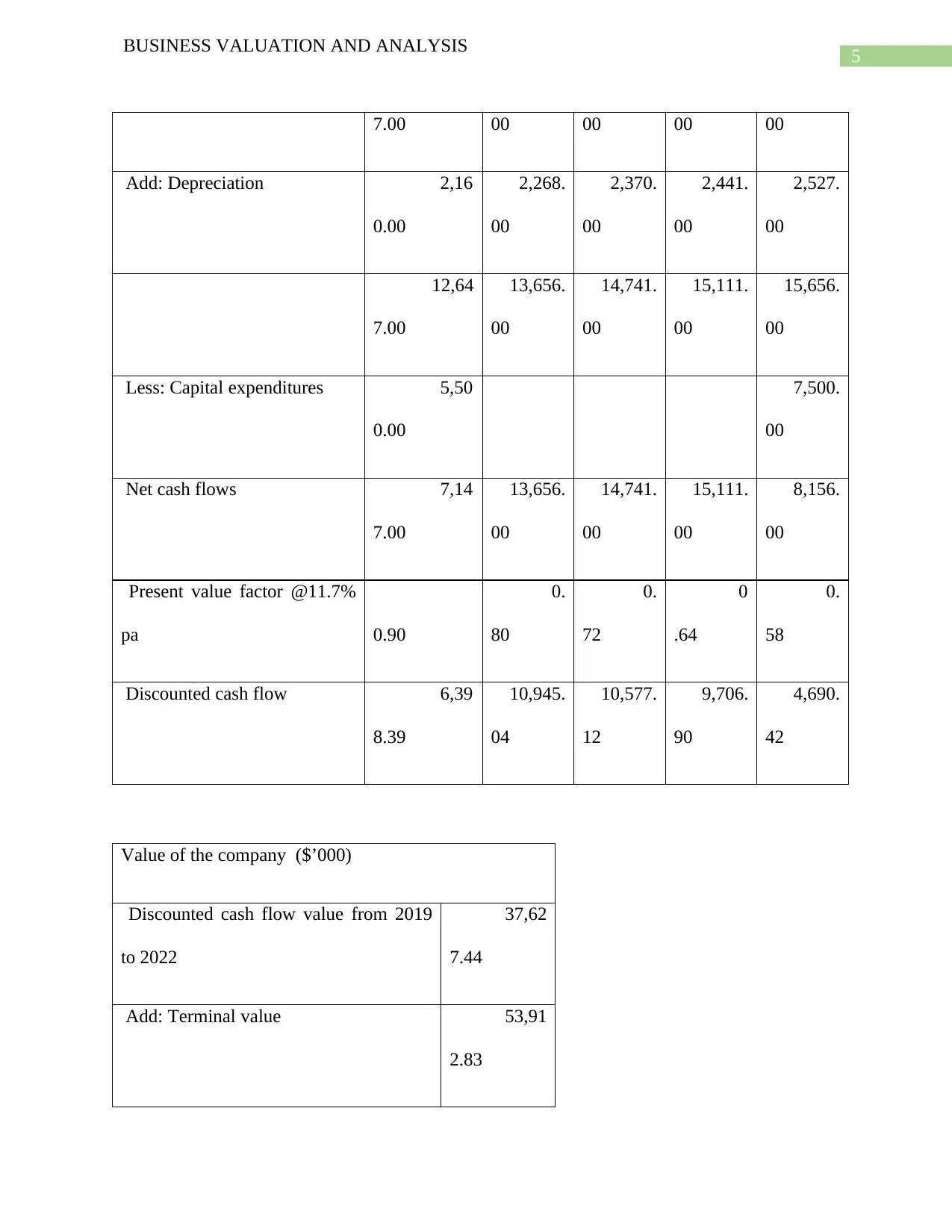
5
BUSINESS VALUATION AND ANALYSIS
7.00 00 00 00 00
Add: Depreciation 2,16
0.00
2,268.
00
2,370.
00
2,441.
00
2,527.
00
12,64
7.00
13,656.
00
14,741.
00
15,111.
00
15,656.
00
Less: Capital expenditures 5,50
0.00
7,500.
00
Net cash flows 7,14
7.00
13,656.
00
14,741.
00
15,111.
00
8,156.
00
Present value factor @11.7%
pa 0.90
0.
80
0.
72
0
.64
0.
58
Discounted cash flow 6,39
8.39
10,945.
04
10,577.
12
9,706.
90
4,690.
42
Value of the company ($’000)
Discounted cash flow value from 2019
to 2022
37,62
7.44
Add: Terminal value 53,91
2.83
BUSINESS VALUATION AND ANALYSIS
7.00 00 00 00 00
Add: Depreciation 2,16
0.00
2,268.
00
2,370.
00
2,441.
00
2,527.
00
12,64
7.00
13,656.
00
14,741.
00
15,111.
00
15,656.
00
Less: Capital expenditures 5,50
0.00
7,500.
00
Net cash flows 7,14
7.00
13,656.
00
14,741.
00
15,111.
00
8,156.
00
Present value factor @11.7%
pa 0.90
0.
80
0.
72
0
.64
0.
58
Discounted cash flow 6,39
8.39
10,945.
04
10,577.
12
9,706.
90
4,690.
42
Value of the company ($’000)
Discounted cash flow value from 2019
to 2022
37,62
7.44
Add: Terminal value 53,91
2.83
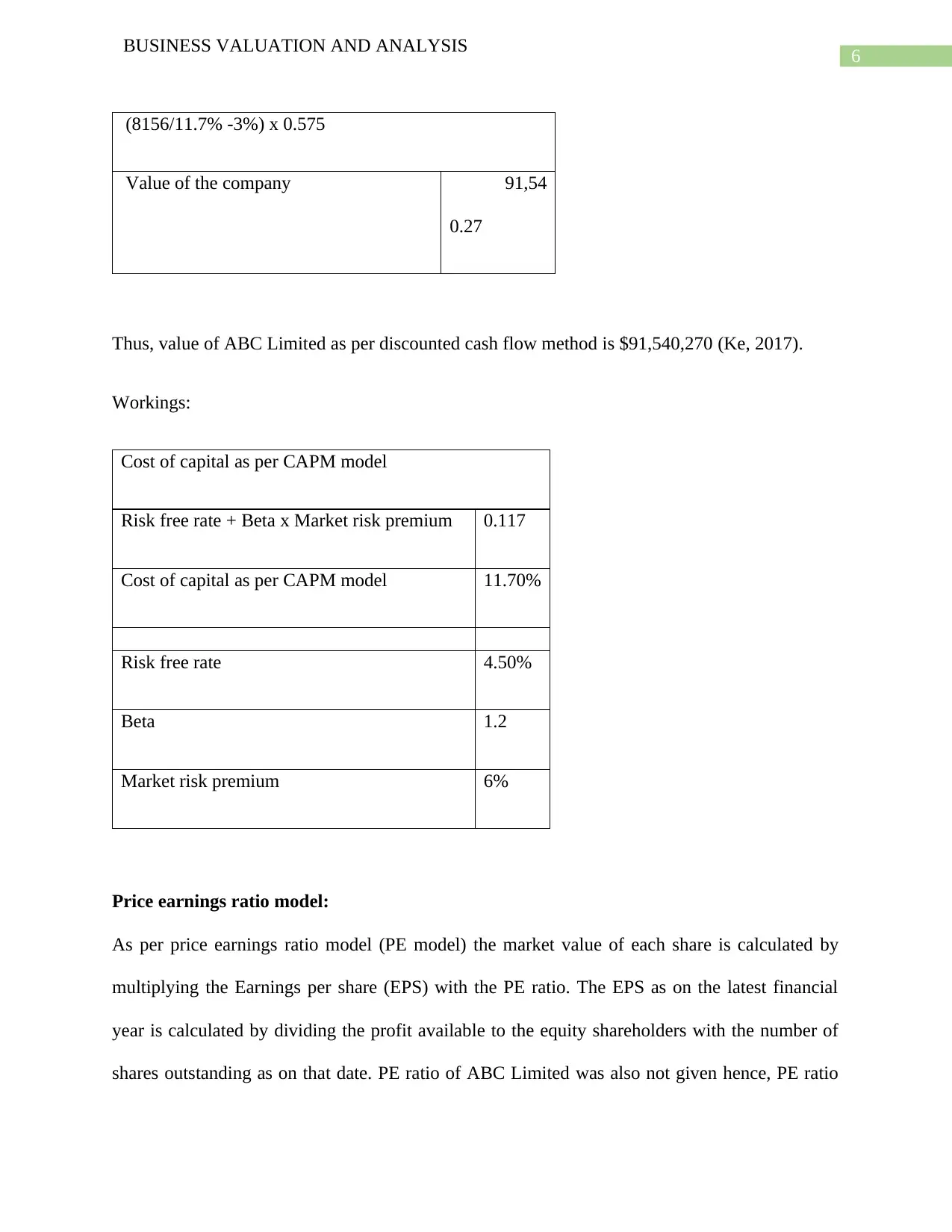
6
BUSINESS VALUATION AND ANALYSIS
(8156/11.7% -3%) x 0.575
Value of the company 91,54
0.27
Thus, value of ABC Limited as per discounted cash flow method is $91,540,270 (Ke, 2017).
Workings:
Cost of capital as per CAPM model
Risk free rate + Beta x Market risk premium 0.117
Cost of capital as per CAPM model 11.70%
Risk free rate 4.50%
Beta 1.2
Market risk premium 6%
Price earnings ratio model:
As per price earnings ratio model (PE model) the market value of each share is calculated by
multiplying the Earnings per share (EPS) with the PE ratio. The EPS as on the latest financial
year is calculated by dividing the profit available to the equity shareholders with the number of
shares outstanding as on that date. PE ratio of ABC Limited was also not given hence, PE ratio
BUSINESS VALUATION AND ANALYSIS
(8156/11.7% -3%) x 0.575
Value of the company 91,54
0.27
Thus, value of ABC Limited as per discounted cash flow method is $91,540,270 (Ke, 2017).
Workings:
Cost of capital as per CAPM model
Risk free rate + Beta x Market risk premium 0.117
Cost of capital as per CAPM model 11.70%
Risk free rate 4.50%
Beta 1.2
Market risk premium 6%
Price earnings ratio model:
As per price earnings ratio model (PE model) the market value of each share is calculated by
multiplying the Earnings per share (EPS) with the PE ratio. The EPS as on the latest financial
year is calculated by dividing the profit available to the equity shareholders with the number of
shares outstanding as on that date. PE ratio of ABC Limited was also not given hence, PE ratio
Paraphrase This Document
Need a fresh take? Get an instant paraphrase of this document with our AI Paraphraser
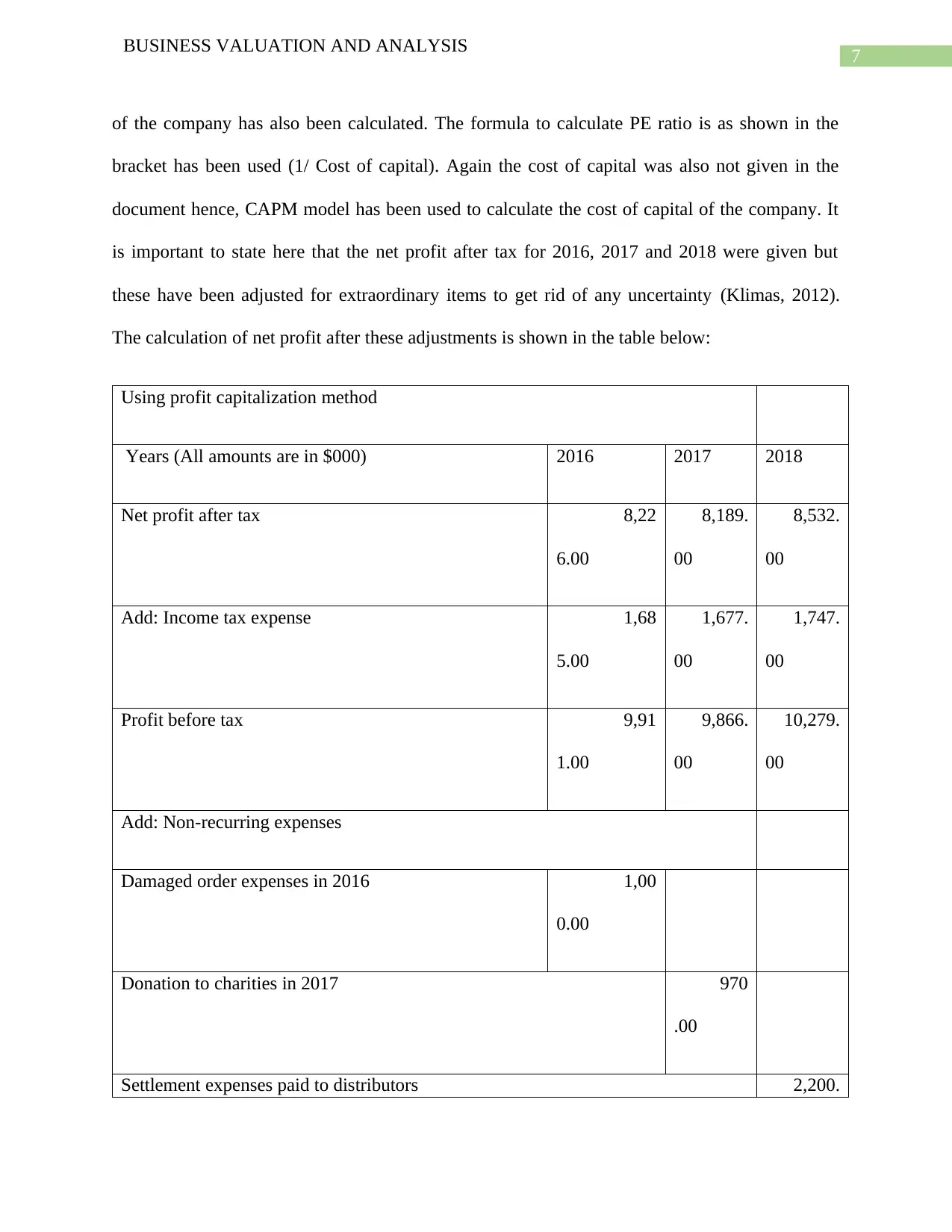
7
BUSINESS VALUATION AND ANALYSIS
of the company has also been calculated. The formula to calculate PE ratio is as shown in the
bracket has been used (1/ Cost of capital). Again the cost of capital was also not given in the
document hence, CAPM model has been used to calculate the cost of capital of the company. It
is important to state here that the net profit after tax for 2016, 2017 and 2018 were given but
these have been adjusted for extraordinary items to get rid of any uncertainty (Klimas, 2012).
The calculation of net profit after these adjustments is shown in the table below:
Using profit capitalization method
Years (All amounts are in $000) 2016 2017 2018
Net profit after tax 8,22
6.00
8,189.
00
8,532.
00
Add: Income tax expense 1,68
5.00
1,677.
00
1,747.
00
Profit before tax 9,91
1.00
9,866.
00
10,279.
00
Add: Non-recurring expenses
Damaged order expenses in 2016 1,00
0.00
Donation to charities in 2017 970
.00
Settlement expenses paid to distributors 2,200.
BUSINESS VALUATION AND ANALYSIS
of the company has also been calculated. The formula to calculate PE ratio is as shown in the
bracket has been used (1/ Cost of capital). Again the cost of capital was also not given in the
document hence, CAPM model has been used to calculate the cost of capital of the company. It
is important to state here that the net profit after tax for 2016, 2017 and 2018 were given but
these have been adjusted for extraordinary items to get rid of any uncertainty (Klimas, 2012).
The calculation of net profit after these adjustments is shown in the table below:
Using profit capitalization method
Years (All amounts are in $000) 2016 2017 2018
Net profit after tax 8,22
6.00
8,189.
00
8,532.
00
Add: Income tax expense 1,68
5.00
1,677.
00
1,747.
00
Profit before tax 9,91
1.00
9,866.
00
10,279.
00
Add: Non-recurring expenses
Damaged order expenses in 2016 1,00
0.00
Donation to charities in 2017 970
.00
Settlement expenses paid to distributors 2,200.
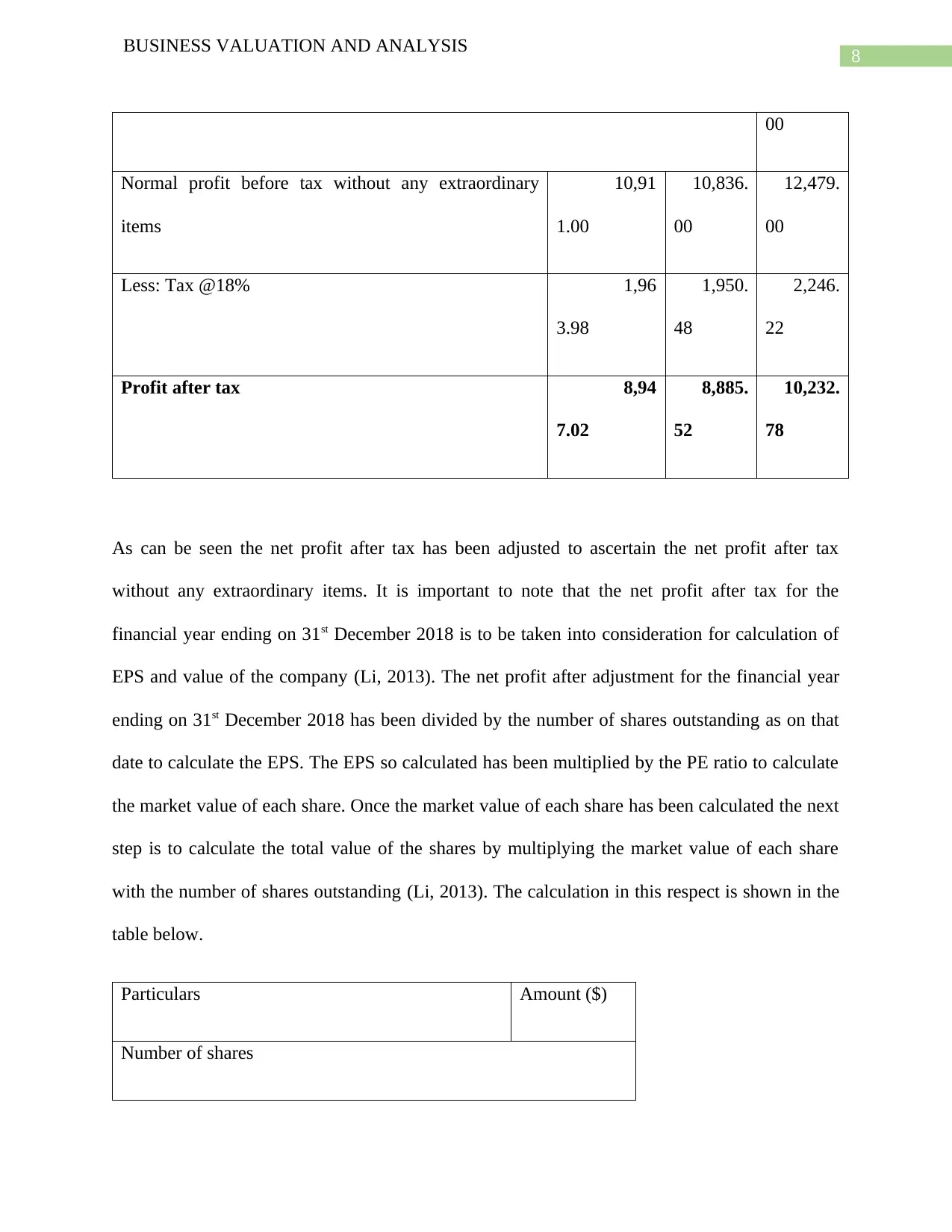
8
BUSINESS VALUATION AND ANALYSIS
00
Normal profit before tax without any extraordinary
items
10,91
1.00
10,836.
00
12,479.
00
Less: Tax @18% 1,96
3.98
1,950.
48
2,246.
22
Profit after tax 8,94
7.02
8,885.
52
10,232.
78
As can be seen the net profit after tax has been adjusted to ascertain the net profit after tax
without any extraordinary items. It is important to note that the net profit after tax for the
financial year ending on 31st December 2018 is to be taken into consideration for calculation of
EPS and value of the company (Li, 2013). The net profit after adjustment for the financial year
ending on 31st December 2018 has been divided by the number of shares outstanding as on that
date to calculate the EPS. The EPS so calculated has been multiplied by the PE ratio to calculate
the market value of each share. Once the market value of each share has been calculated the next
step is to calculate the total value of the shares by multiplying the market value of each share
with the number of shares outstanding (Li, 2013). The calculation in this respect is shown in the
table below.
Particulars Amount ($)
Number of shares
BUSINESS VALUATION AND ANALYSIS
00
Normal profit before tax without any extraordinary
items
10,91
1.00
10,836.
00
12,479.
00
Less: Tax @18% 1,96
3.98
1,950.
48
2,246.
22
Profit after tax 8,94
7.02
8,885.
52
10,232.
78
As can be seen the net profit after tax has been adjusted to ascertain the net profit after tax
without any extraordinary items. It is important to note that the net profit after tax for the
financial year ending on 31st December 2018 is to be taken into consideration for calculation of
EPS and value of the company (Li, 2013). The net profit after adjustment for the financial year
ending on 31st December 2018 has been divided by the number of shares outstanding as on that
date to calculate the EPS. The EPS so calculated has been multiplied by the PE ratio to calculate
the market value of each share. Once the market value of each share has been calculated the next
step is to calculate the total value of the shares by multiplying the market value of each share
with the number of shares outstanding (Li, 2013). The calculation in this respect is shown in the
table below.
Particulars Amount ($)
Number of shares
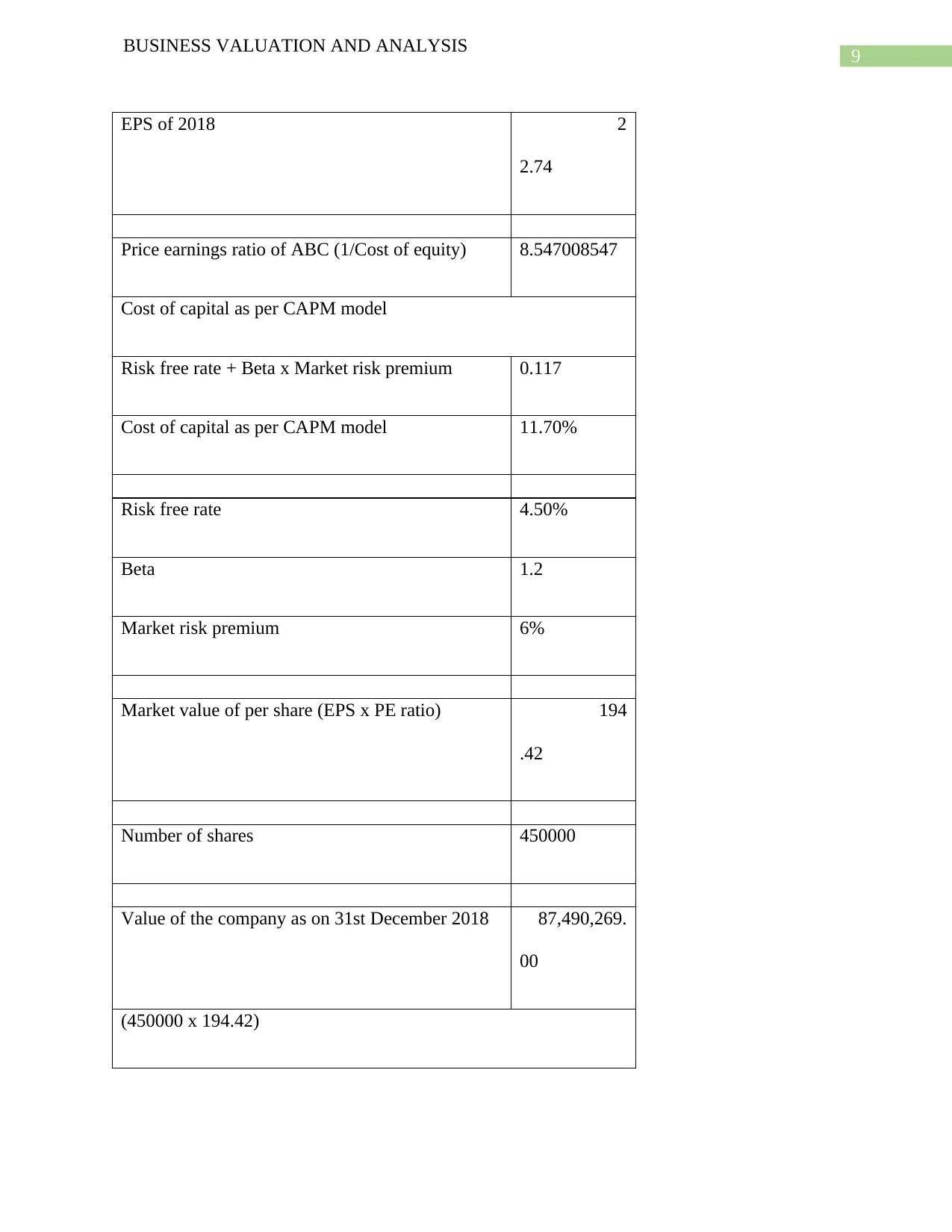
9
BUSINESS VALUATION AND ANALYSIS
EPS of 2018 2
2.74
Price earnings ratio of ABC (1/Cost of equity) 8.547008547
Cost of capital as per CAPM model
Risk free rate + Beta x Market risk premium 0.117
Cost of capital as per CAPM model 11.70%
Risk free rate 4.50%
Beta 1.2
Market risk premium 6%
Market value of per share (EPS x PE ratio) 194
.42
Number of shares 450000
Value of the company as on 31st December 2018 87,490,269.
00
(450000 x 194.42)
BUSINESS VALUATION AND ANALYSIS
EPS of 2018 2
2.74
Price earnings ratio of ABC (1/Cost of equity) 8.547008547
Cost of capital as per CAPM model
Risk free rate + Beta x Market risk premium 0.117
Cost of capital as per CAPM model 11.70%
Risk free rate 4.50%
Beta 1.2
Market risk premium 6%
Market value of per share (EPS x PE ratio) 194
.42
Number of shares 450000
Value of the company as on 31st December 2018 87,490,269.
00
(450000 x 194.42)
Secure Best Marks with AI Grader
Need help grading? Try our AI Grader for instant feedback on your assignments.
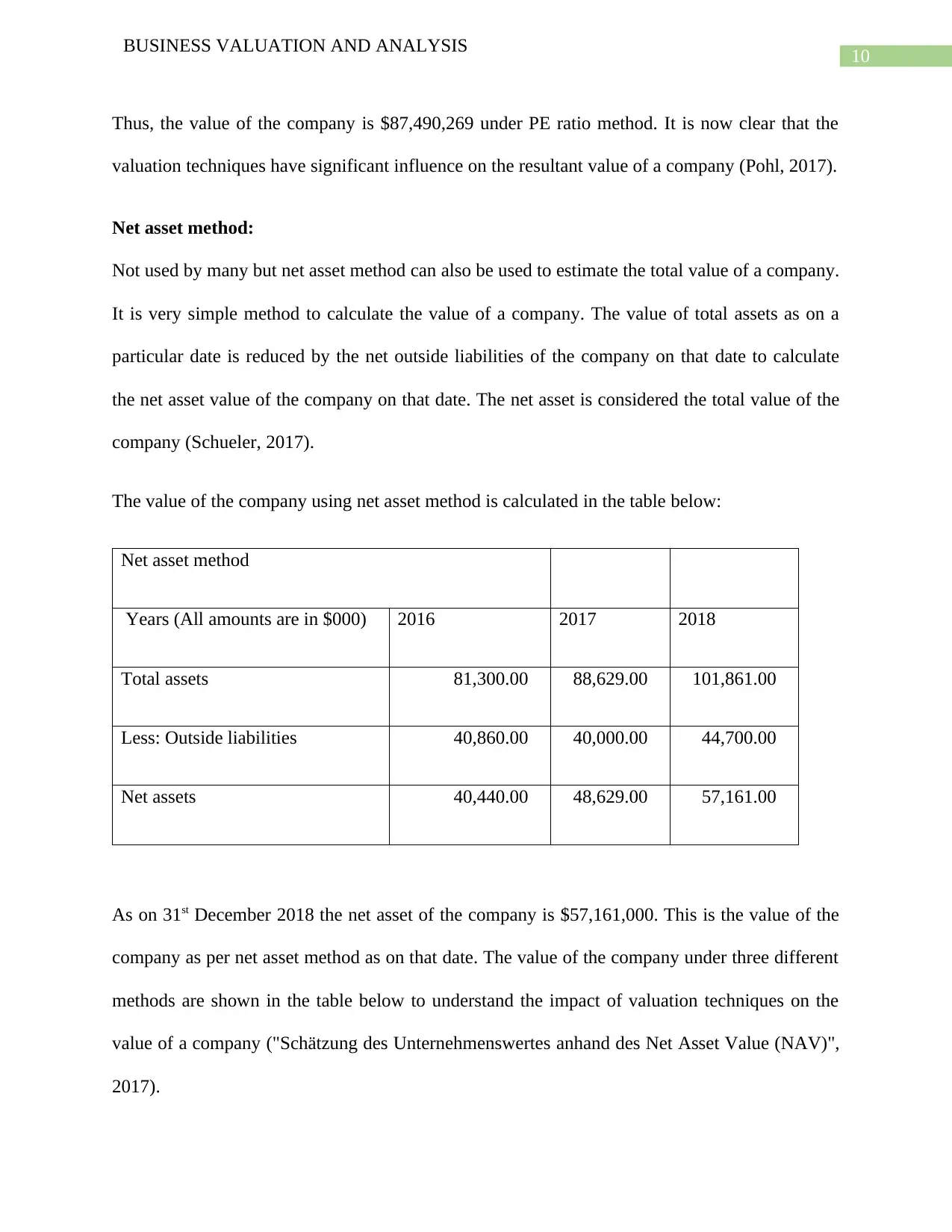
10
BUSINESS VALUATION AND ANALYSIS
Thus, the value of the company is $87,490,269 under PE ratio method. It is now clear that the
valuation techniques have significant influence on the resultant value of a company (Pohl, 2017).
Net asset method:
Not used by many but net asset method can also be used to estimate the total value of a company.
It is very simple method to calculate the value of a company. The value of total assets as on a
particular date is reduced by the net outside liabilities of the company on that date to calculate
the net asset value of the company on that date. The net asset is considered the total value of the
company (Schueler, 2017).
The value of the company using net asset method is calculated in the table below:
Net asset method
Years (All amounts are in $000) 2016 2017 2018
Total assets 81,300.00 88,629.00 101,861.00
Less: Outside liabilities 40,860.00 40,000.00 44,700.00
Net assets 40,440.00 48,629.00 57,161.00
As on 31st December 2018 the net asset of the company is $57,161,000. This is the value of the
company as per net asset method as on that date. The value of the company under three different
methods are shown in the table below to understand the impact of valuation techniques on the
value of a company ("Schätzung des Unternehmenswertes anhand des Net Asset Value (NAV)",
2017).
BUSINESS VALUATION AND ANALYSIS
Thus, the value of the company is $87,490,269 under PE ratio method. It is now clear that the
valuation techniques have significant influence on the resultant value of a company (Pohl, 2017).
Net asset method:
Not used by many but net asset method can also be used to estimate the total value of a company.
It is very simple method to calculate the value of a company. The value of total assets as on a
particular date is reduced by the net outside liabilities of the company on that date to calculate
the net asset value of the company on that date. The net asset is considered the total value of the
company (Schueler, 2017).
The value of the company using net asset method is calculated in the table below:
Net asset method
Years (All amounts are in $000) 2016 2017 2018
Total assets 81,300.00 88,629.00 101,861.00
Less: Outside liabilities 40,860.00 40,000.00 44,700.00
Net assets 40,440.00 48,629.00 57,161.00
As on 31st December 2018 the net asset of the company is $57,161,000. This is the value of the
company as per net asset method as on that date. The value of the company under three different
methods are shown in the table below to understand the impact of valuation techniques on the
value of a company ("Schätzung des Unternehmenswertes anhand des Net Asset Value (NAV)",
2017).
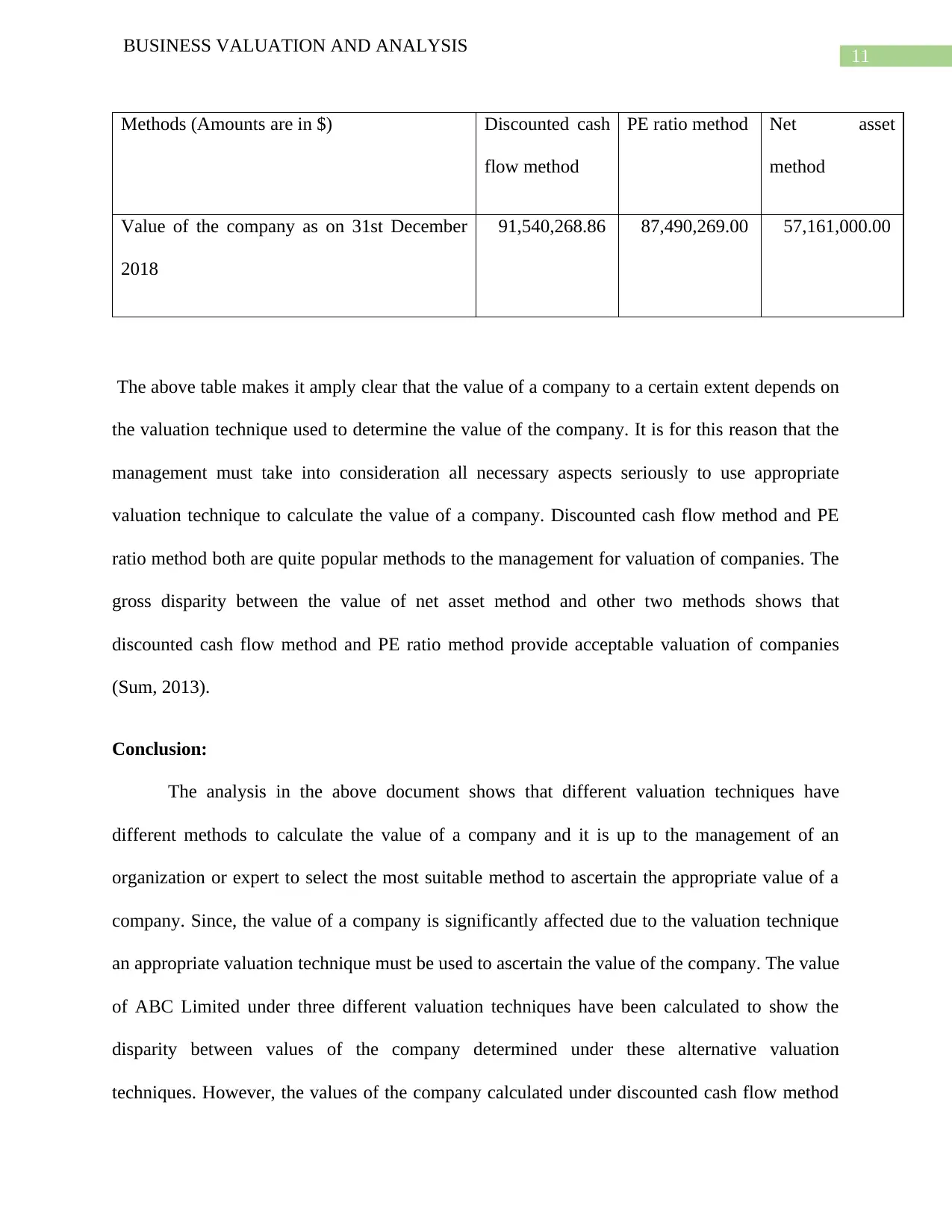
11
BUSINESS VALUATION AND ANALYSIS
Methods (Amounts are in $) Discounted cash
flow method
PE ratio method Net asset
method
Value of the company as on 31st December
2018
91,540,268.86 87,490,269.00 57,161,000.00
The above table makes it amply clear that the value of a company to a certain extent depends on
the valuation technique used to determine the value of the company. It is for this reason that the
management must take into consideration all necessary aspects seriously to use appropriate
valuation technique to calculate the value of a company. Discounted cash flow method and PE
ratio method both are quite popular methods to the management for valuation of companies. The
gross disparity between the value of net asset method and other two methods shows that
discounted cash flow method and PE ratio method provide acceptable valuation of companies
(Sum, 2013).
Conclusion:
The analysis in the above document shows that different valuation techniques have
different methods to calculate the value of a company and it is up to the management of an
organization or expert to select the most suitable method to ascertain the appropriate value of a
company. Since, the value of a company is significantly affected due to the valuation technique
an appropriate valuation technique must be used to ascertain the value of the company. The value
of ABC Limited under three different valuation techniques have been calculated to show the
disparity between values of the company determined under these alternative valuation
techniques. However, the values of the company calculated under discounted cash flow method
BUSINESS VALUATION AND ANALYSIS
Methods (Amounts are in $) Discounted cash
flow method
PE ratio method Net asset
method
Value of the company as on 31st December
2018
91,540,268.86 87,490,269.00 57,161,000.00
The above table makes it amply clear that the value of a company to a certain extent depends on
the valuation technique used to determine the value of the company. It is for this reason that the
management must take into consideration all necessary aspects seriously to use appropriate
valuation technique to calculate the value of a company. Discounted cash flow method and PE
ratio method both are quite popular methods to the management for valuation of companies. The
gross disparity between the value of net asset method and other two methods shows that
discounted cash flow method and PE ratio method provide acceptable valuation of companies
(Sum, 2013).
Conclusion:
The analysis in the above document shows that different valuation techniques have
different methods to calculate the value of a company and it is up to the management of an
organization or expert to select the most suitable method to ascertain the appropriate value of a
company. Since, the value of a company is significantly affected due to the valuation technique
an appropriate valuation technique must be used to ascertain the value of the company. The value
of ABC Limited under three different valuation techniques have been calculated to show the
disparity between values of the company determined under these alternative valuation
techniques. However, the values of the company calculated under discounted cash flow method
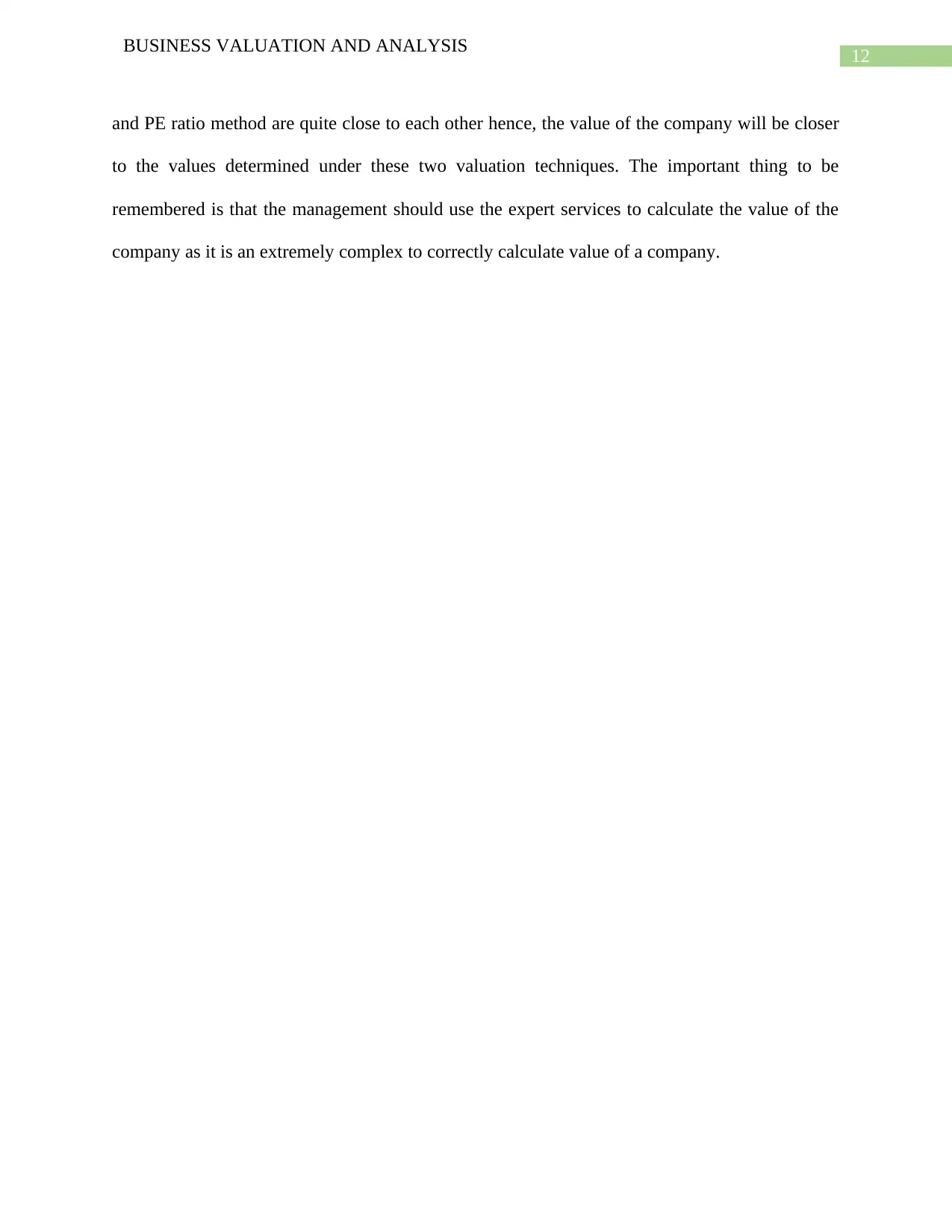
12
BUSINESS VALUATION AND ANALYSIS
and PE ratio method are quite close to each other hence, the value of the company will be closer
to the values determined under these two valuation techniques. The important thing to be
remembered is that the management should use the expert services to calculate the value of the
company as it is an extremely complex to correctly calculate value of a company.
BUSINESS VALUATION AND ANALYSIS
and PE ratio method are quite close to each other hence, the value of the company will be closer
to the values determined under these two valuation techniques. The important thing to be
remembered is that the management should use the expert services to calculate the value of the
company as it is an extremely complex to correctly calculate value of a company.
Paraphrase This Document
Need a fresh take? Get an instant paraphrase of this document with our AI Paraphraser
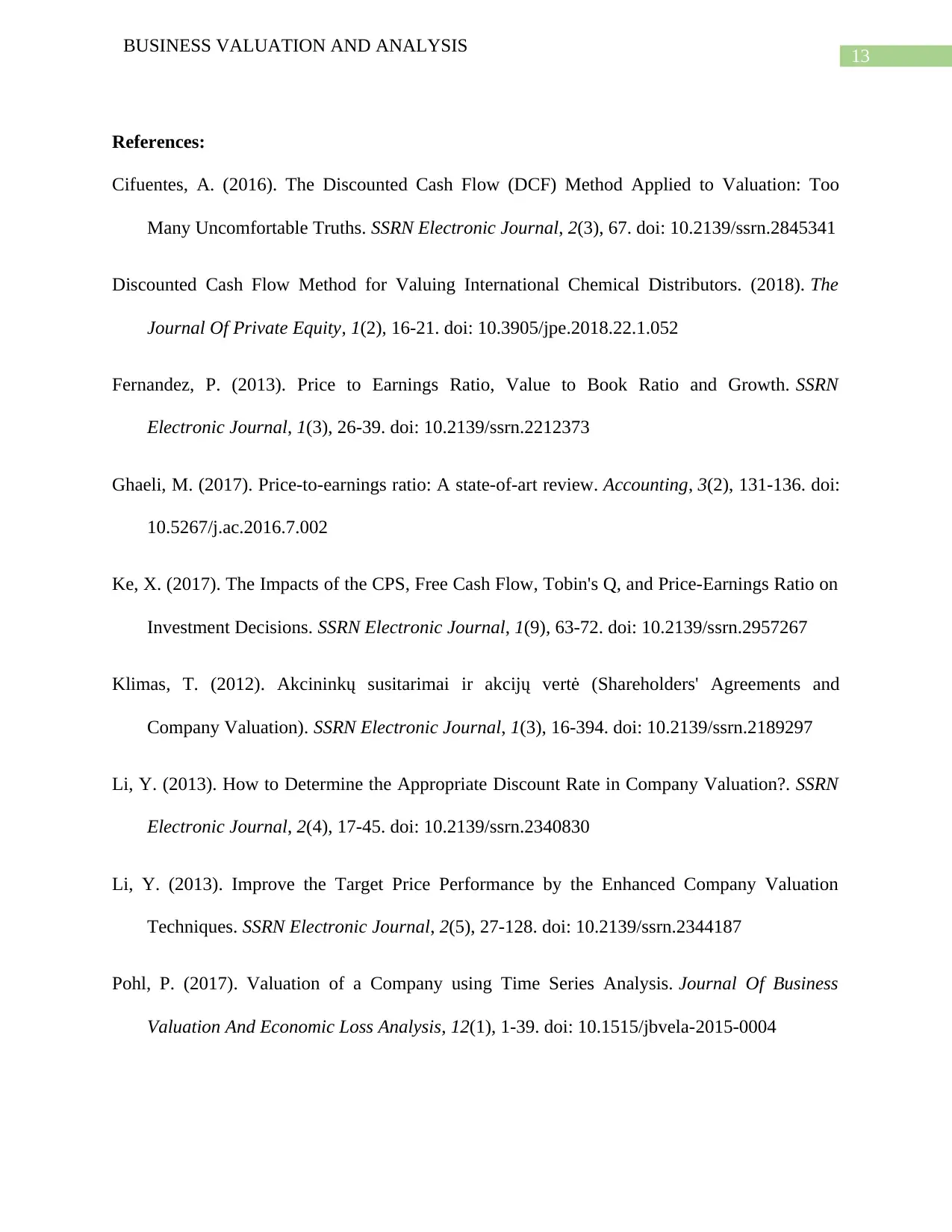
13
BUSINESS VALUATION AND ANALYSIS
References:
Cifuentes, A. (2016). The Discounted Cash Flow (DCF) Method Applied to Valuation: Too
Many Uncomfortable Truths. SSRN Electronic Journal, 2(3), 67. doi: 10.2139/ssrn.2845341
Discounted Cash Flow Method for Valuing International Chemical Distributors. (2018). The
Journal Of Private Equity, 1(2), 16-21. doi: 10.3905/jpe.2018.22.1.052
Fernandez, P. (2013). Price to Earnings Ratio, Value to Book Ratio and Growth. SSRN
Electronic Journal, 1(3), 26-39. doi: 10.2139/ssrn.2212373
Ghaeli, M. (2017). Price-to-earnings ratio: A state-of-art review. Accounting, 3(2), 131-136. doi:
10.5267/j.ac.2016.7.002
Ke, X. (2017). The Impacts of the CPS, Free Cash Flow, Tobin's Q, and Price-Earnings Ratio on
Investment Decisions. SSRN Electronic Journal, 1(9), 63-72. doi: 10.2139/ssrn.2957267
Klimas, T. (2012). Akcininkų susitarimai ir akcijų vertė (Shareholders' Agreements and
Company Valuation). SSRN Electronic Journal, 1(3), 16-394. doi: 10.2139/ssrn.2189297
Li, Y. (2013). How to Determine the Appropriate Discount Rate in Company Valuation?. SSRN
Electronic Journal, 2(4), 17-45. doi: 10.2139/ssrn.2340830
Li, Y. (2013). Improve the Target Price Performance by the Enhanced Company Valuation
Techniques. SSRN Electronic Journal, 2(5), 27-128. doi: 10.2139/ssrn.2344187
Pohl, P. (2017). Valuation of a Company using Time Series Analysis. Journal Of Business
Valuation And Economic Loss Analysis, 12(1), 1-39. doi: 10.1515/jbvela-2015-0004
BUSINESS VALUATION AND ANALYSIS
References:
Cifuentes, A. (2016). The Discounted Cash Flow (DCF) Method Applied to Valuation: Too
Many Uncomfortable Truths. SSRN Electronic Journal, 2(3), 67. doi: 10.2139/ssrn.2845341
Discounted Cash Flow Method for Valuing International Chemical Distributors. (2018). The
Journal Of Private Equity, 1(2), 16-21. doi: 10.3905/jpe.2018.22.1.052
Fernandez, P. (2013). Price to Earnings Ratio, Value to Book Ratio and Growth. SSRN
Electronic Journal, 1(3), 26-39. doi: 10.2139/ssrn.2212373
Ghaeli, M. (2017). Price-to-earnings ratio: A state-of-art review. Accounting, 3(2), 131-136. doi:
10.5267/j.ac.2016.7.002
Ke, X. (2017). The Impacts of the CPS, Free Cash Flow, Tobin's Q, and Price-Earnings Ratio on
Investment Decisions. SSRN Electronic Journal, 1(9), 63-72. doi: 10.2139/ssrn.2957267
Klimas, T. (2012). Akcininkų susitarimai ir akcijų vertė (Shareholders' Agreements and
Company Valuation). SSRN Electronic Journal, 1(3), 16-394. doi: 10.2139/ssrn.2189297
Li, Y. (2013). How to Determine the Appropriate Discount Rate in Company Valuation?. SSRN
Electronic Journal, 2(4), 17-45. doi: 10.2139/ssrn.2340830
Li, Y. (2013). Improve the Target Price Performance by the Enhanced Company Valuation
Techniques. SSRN Electronic Journal, 2(5), 27-128. doi: 10.2139/ssrn.2344187
Pohl, P. (2017). Valuation of a Company using Time Series Analysis. Journal Of Business
Valuation And Economic Loss Analysis, 12(1), 1-39. doi: 10.1515/jbvela-2015-0004
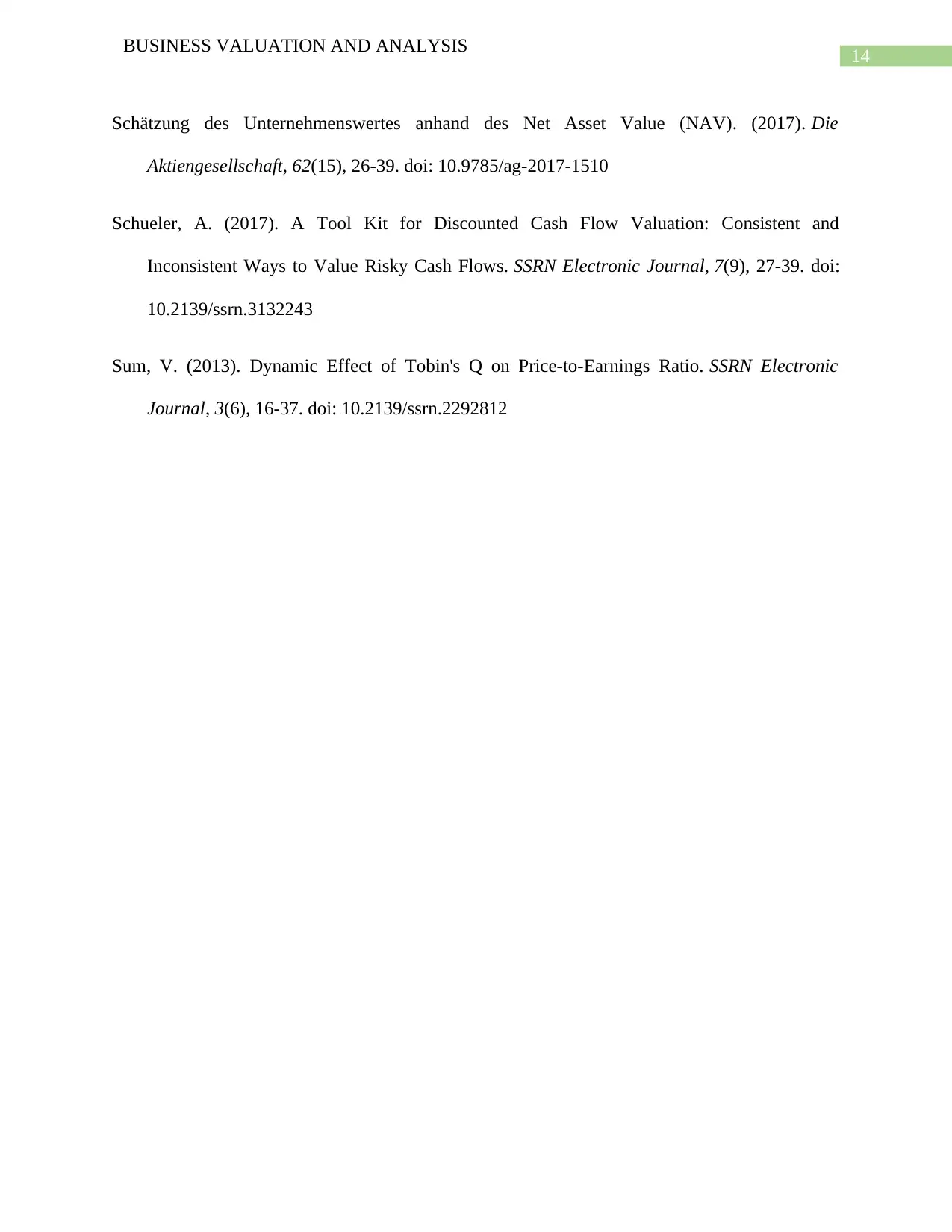
14
BUSINESS VALUATION AND ANALYSIS
Schätzung des Unternehmenswertes anhand des Net Asset Value (NAV). (2017). Die
Aktiengesellschaft, 62(15), 26-39. doi: 10.9785/ag-2017-1510
Schueler, A. (2017). A Tool Kit for Discounted Cash Flow Valuation: Consistent and
Inconsistent Ways to Value Risky Cash Flows. SSRN Electronic Journal, 7(9), 27-39. doi:
10.2139/ssrn.3132243
Sum, V. (2013). Dynamic Effect of Tobin's Q on Price-to-Earnings Ratio. SSRN Electronic
Journal, 3(6), 16-37. doi: 10.2139/ssrn.2292812
BUSINESS VALUATION AND ANALYSIS
Schätzung des Unternehmenswertes anhand des Net Asset Value (NAV). (2017). Die
Aktiengesellschaft, 62(15), 26-39. doi: 10.9785/ag-2017-1510
Schueler, A. (2017). A Tool Kit for Discounted Cash Flow Valuation: Consistent and
Inconsistent Ways to Value Risky Cash Flows. SSRN Electronic Journal, 7(9), 27-39. doi:
10.2139/ssrn.3132243
Sum, V. (2013). Dynamic Effect of Tobin's Q on Price-to-Earnings Ratio. SSRN Electronic
Journal, 3(6), 16-37. doi: 10.2139/ssrn.2292812
1 out of 15
Related Documents
Your All-in-One AI-Powered Toolkit for Academic Success.
+13062052269
info@desklib.com
Available 24*7 on WhatsApp / Email
![[object Object]](/_next/static/media/star-bottom.7253800d.svg)
Unlock your academic potential
© 2024 | Zucol Services PVT LTD | All rights reserved.




